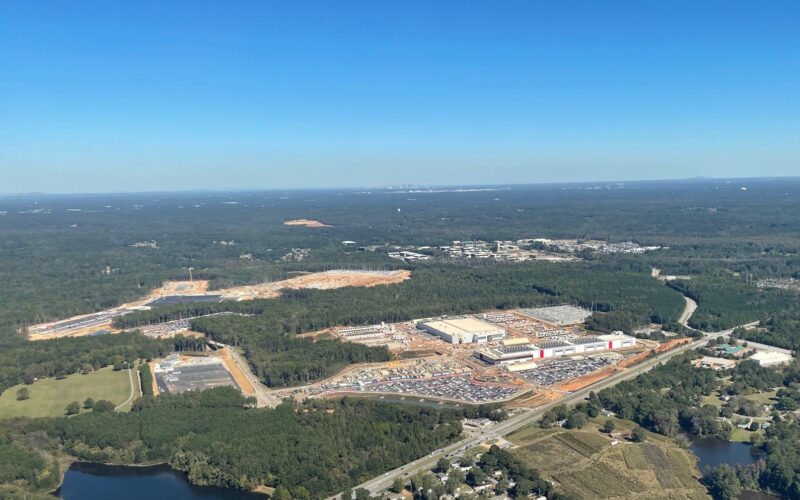Just as the word “Chattahoochee” originates from the Creek/Muskogee word meaning painted rock, the resource we know as the Chattahoochee River today was first significant to many indigenous Americans tribes.
In recognition of National Native American Heritage Month, here are some sites along the Chattahoochee River that pay tribute to the rich traditions of indigenous cultures.
Nacoochee Indian Mound
Heading into Helen, Georgia from the east, it’s hard to miss Nacoochee Indian Mound, which sits just a few miles away from the Chattahoochee River. The Indian mound dates back more than 1000 years, likely when the site was occupied by the Cherokee, who remained as late as the mid-1700s. The gazebo on top, however, was constructed in the late 1800s. “Excavations of the mound in 1915 revealed 75 human burials, many accompanied by high-status items such as copper axes, effigy vases, and conch shell beads and cups,” reports Joe Cook in his Chattahoochee River User’s Guide, which offers an insightful look at the river and its history. Cook explains that burial mounds like that found at Nacoochee are common along rivers because of the symbolic weight water carries in ceremonial rites.
McIntosh Reserve Park
Where park visitors now camp, hike, and picnic was once the site of a tragic culture clash between factions of the Creek nation disputing the sale of their land to the State of Georgia. The murder of Chief William McIntosh at the site of the park was called “the signal for a ferocious Indian war, bursting upon us like a thunderbolt” by President John Adams in his diary on May 16, 1825. McIntosh was the son of a Scottish captain in the British army and a Creek woman belonging to the influential Wind Clan. McIntosh ultimately became a chief with a lower Creek faction and later operated a backwoods plantation, tavern, and ferry on the Chattahoochee River. The park is now managed by Carroll County and has been assisted in part by a Land and Water Conservation Grant, Heritage Conservation and Recreation Service, U.S. Department of Interior. (source)
Kolomoki Indian Mounds
Home to one of the southeast’s oldest mounds, Kolomoki Indian Mounds date back to when the site was occupied by indigenous people between 350 and 750 A.D. The great temple mound stands 57 feet high, towering over two nearby smaller burial mounds and several ceremonial mounds. Currently managed by Georgia State Parks, a museum has been constructed near one of the excavated mounds, providing a look at how the mounds’ creators lived. (source)
Dugout Canoe Discovery
In 1974, fishing guide Delbert Greear of Helen, Georgia uncovered a dugout canoe near the mouth of Mauldin Mill Creek, close to mile 20.1 of the Chattahoochee River. The 24-feet long and 2-feet wide vessel was crafted from yellow pine by Cherokee Indians. It now sits on display of the Museum of the Cherokee Indian in Cherokee, North Carolina. (Cook)
Omussee Mound
The Omussee mound surprised residents of the nearby community on multiple occasions. Dating back to 1300, it went unnoticed for some time before being excavated by archaeologists in the 1950s. It also defied expectations during the creation of Lake Eufaula, when it, and other mound sites along the Chattahoochee River, were anticipated to be flooded. The Omussee mound represented the southernmost mound village along the Chattahoochee, which, the Dothan Eagle reports, could mean that the Chacato people living there had a large sphere of influence before their decline in 1550. The Chacato people are considered ancestors of the Creek nation, who settled a village nearby known as Yamassee, which is the source of the Omussee name. Omussee mound is now part of the Historic Chattahoochee Commission’s Creek Heritage Trail.
Thornton Shoals/Indian Cave
Explore the trails near mile 130.6 of the Chattahoochee River and you may come across what is known as the Indian cave. The large overhang rock structure is believed to have sheltered nearby Native Americans for thousands of years, writes Cook. It is one of 180 archaeological sites identified within the Chattahoochee River National Recreation Area.
City of Franklin/Chattahoochee Old Town
While the city of Franklin, Georgia was named to honor Benjamin Franklin, it is believed to sit on the site of the Creek town, Chattahoochee. The community is widely considered to be the source of the nearby river’s name thanks to the 1799 account by US Indian agent Benjamin Hawkins, who writes “The name of the river derived from ‘Chatto,’ a stone, and ‘hoche,’ marked or flowered.” (Cook) Visit nearby Brush Creek Park to walk the trails and see the Chattahoochee River as it flows into West Point Lake.
Hichitee Creek
Named for the Hichitee, or Hichiti, group of Creek Indians, this creek was once the location of a tragic and deadly war for independence. In 1836, the Hichiti took up arms against white settlers who were unjustly forcing the group out of their ancestral lands. The Georgia militia opened fire on the Native Americans as they attempted to launch their canoe from the western bank of the river. The hour-long war left at least six Creeks and one Georgia militiaman dead. (Cook)
While the legacy of Native Americans remains present throughout these and other sites across the Chattahoochee watershed, it’s important to note that much of the history of the peoples listed here was corrupted, cut short, or eliminated due to the actions of local, state, and federal government, culminating in the forced removal of many tribes in the early 1800s.
In 1802, the state of Georgia relinquished their claim to the lands west of the Chattahoochee River, most of which is now part of Alabama, in exchange for the federal government’s pledge to remove all Native Americans from the state. The discovery of gold in 1828 prompted the state to enforce its laws over the Cherokee Nation, whose lands were later gifted to white residents, even though the Cherokee had been guaranteed the right to their land by multiple past treaties and a US Supreme Court ruling.
The Indian Removal Act eventually led government soldiers to violently force thousands of Choctaw, Creek, Chickasaw, and Cherokee Native Americans away from their homes toward the west. “Cherokee removal from Georgia was an American act of opportunistic oppression,” writes the National Park Service. “Going west, the Georgia Cherokee would be taken from the bones of their ancestors—to a new land, new waterways, new resources.” (source)
We owe both the name of our river, and therefore, our mission, to Native Americans. As part of our goal to protect the Chattahoochee River, it’s vital that we recognize the complex history of our shared waterways and those who depended on this liquid lifeline hundreds and thousands of years ago.



